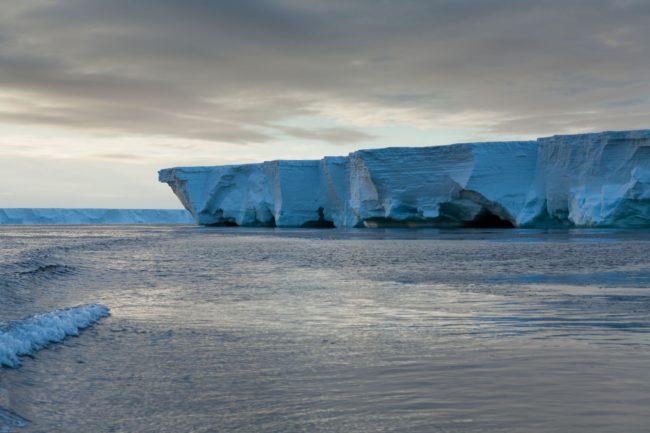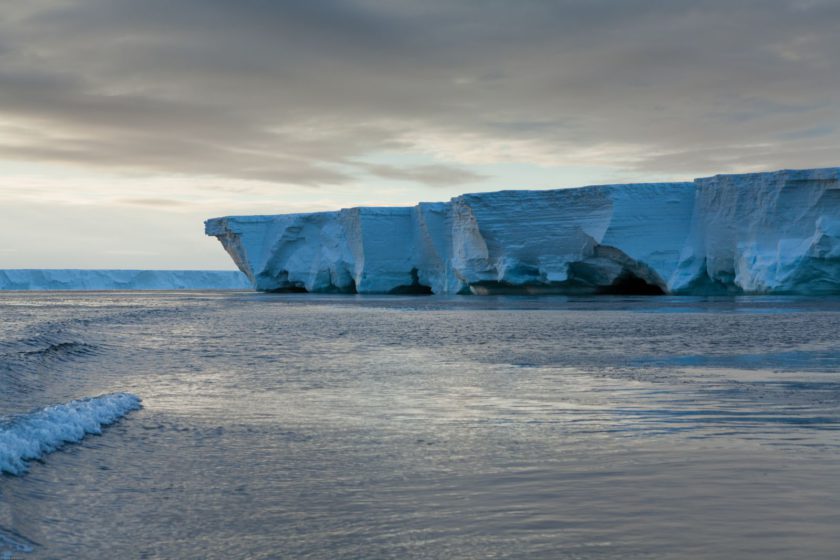
A new study reveals some rather bad news for Antarctica’s Ross Ice Shelf. The study, titled “Basal melting of Ross Ice Shelf from solar heat absorption in an ice-front polynya“, was published within Nature Geoscience on 29th April, and reveals that ice is melting much more rapidly than previously thought due to inflowing warm water.
Dr Craig Stewart, the lead author from the National Institute of Water and Atmospheric Research (NIWA) in New Zealand, who conducted the work while a PhD student at the University of Cambridge, explains …
The stability of ice shelves is generally thought to be related to their exposure to warm deep ocean water, but we’ve found that solar heated surface water also plays a crucial role in melting ice shelves
Why does this matter?
The presence of an ice shelf brings stability, hence if it collapses, then it leads to much more. The Ross Ice Shelf stabilises the West Antarctic ice sheet by blocking the ice which flows into it from some of the world’s largest glaciers.
“Previous studies have shown that when ice shelves collapse, the feeding glaciers can speed up by a factor or two or three,” … said co-author Dr Poul Christoffersen from Cambridge’s Scott Polar Research Institute … “The difference here is the sheer size of Ross Ice Shelf, which over one hundred times larger than the ice shelves we’ve already seen disappear.”
How did they work this out?
The team collected four years of data from an oceanographic mooring installed under the Ross Ice Shelf by collaborators at NIWA (National Institute of Water and Atmospheric Research). Using instruments deployed through a 260 metre-deep borehole, the team measured temperature, salinity, melt rates and ocean currents in the cavity under the ice.
The team also used an extremely precise custom-made radar system to survey the changing thickness of the ice shelf. Supported by Antarctica New Zealand and the Rutherford Foundation’s Scott Centenary Scholarship at the Scott Polar Research Institute, Dr Stewart and Dr Christoffersen travelled more than 1000 km by snowmobile in order to measure ice thicknesses and map basal melt rates.
What exactly did they find?
Data from the instruments deployed on the mooring showed that solar heated surface water flows into the cavity under the ice shelf near Ross Island, causing melt rates to nearly triple during the summer months.
The melting is affected by a large area of open ocean in front of the ice shelf that is empty of sea ice due to strong offshore winds. This area, known as the Ross Sea Polynya, absorbs solar heat quickly in summer and this solar heat source is clearly influencing melting in the ice shelf cavity.
The findings suggest that conditions in the ice shelf cavity are more closely coupled with the surface ocean and atmosphere than previously assumed, implying that melt rates near the ice front will respond quickly to changes in the uppermost layer of the ocean.
What are the Implications of all this?
“Climate change is likely to result in less sea ice, and higher surface ocean temperatures in the Ross Sea, suggesting that melt rates in this region will increase in the future,” …. said Stewart.
The potential for increasing melt rates in this region has implications for ice shelf stability due to the shape of the ice shelf. Rapid melting identified by the study happens beneath a thin and structurally important part of the ice shelf, where the ice pushes against Ross Island. Pressure from the island, transmitted through this region, slows the flow of the entire ice shelf.
“The observations we made at the front of the ice shelf have direct implications for many large glaciers that flow into the ice shelf, some as far as 900 km away,” … said Christoffersen.
Is the Ross Ice Shelf about to Collapse?
No.
While the Ross Ice Shelf is considered to be relatively stable, the new findings show that it may be more vulnerable than thought so far. The point of vulnerability lies in the fact that that solar heated surface water flows into the cavity near a stabilising pinning point, which could be undermined if basal melting intensifies further. The study shows that melting in this specific region is 10 times higher than the average melt rate expected for the ice shelf as a whole.
The researchers point out that melting measured by the study does not imply that the ice shelf is currently unstable. The ice shelf has evolved over time and ice lost by melting due to inflow of warm water is roughly balanced by the inputs of ice from feeding glaciers and snow accumulation. This balance is, however, depending on the stability provided by the Ross Island pinning point, which the new study identifies as a point of future vulnerability.
A deeper Dive
The following is a direct extract from the paper …
The identification of surface layer heat as a driver of basal melting of the Ross Ice Shelf has several important implications.
First, as heat absorption within the polynya is controlled by atmospheric processes, basal mass balance in the frontal zone of the ice shelf is likely to vary with atmospheric and surface ocean conditions near the ice front on seasonal, interannual and longer-term timescales. Considering that summer sea-ice concentrations in the Ross Sea are projected to decrease by 56% by 2050, and that the ice-free period is also expected to increase, it seems likely that ice-shelf basal melting in this region will also increase rapidly. If surface warming and sea-ice loss are widespread, this process may also become more widespread.
Second, Antarctic Surface Water drives a mode of basal ablation that is distinct from that of denser water masses, and these differences have implications for ice shelf stability. For example, whereas meltwater derived from high salinity shelf water can refreeze in shallower regions, potentially stabilizing ice shelves, meltwater formed from Antarctic Surface Water is unlikely to be redeposited due to its relative warmth. Furthermore, the influence of surface water is greatest in frontal regions. Although some frontal regions are unimportant to the stability of ice shelves, others contain critical pinning points that sustain the location of the front. Ross Island seems to be one such pinning point, and recent modelling shows that the rapid melting identified here influences a structurally critical region in which ice thickness changes can influence the flow speed of the entire ice shelf.
The exposure of this sensitive part of the ice shelf to surface ocean heat implies that the grounding line flux of the entire ice shelf may be modulated at seasonal to interannual timescales by surface water inflow. This process represents a frequently overlooked, but potentially important, factor in regional ice-shelf mass balance and should be considered in future assessments of ice shelf stability.
Location Illustration

In the above illustration extracted from the paper, they illustrate the Sea Surface Temperature (SST) and sea-ice concentration around Antarctica.
- a, Long-term mean January Sea Surface Temperature (colour scale) with the 15% sea ice concentration contour (red).
- b, Close-up map of the Ross Sea showing the January mean 0 °C Sea Surface Temperature isotherm (white) and the 15% sea-ice concentration contours for November and December.
- c, MODIS image taken during strong southerly airfow on 12 November 2015.
Grey boxes in a and b indicate the regions shown in b and c, respectively. The red star indicates the mooring location.
